
Axbridge is a town in Somerset, England, on the River Axe, near the southern edge of the Mendip Hills. Its population according to the 2011 census was 2,057.
A grandfather clock is a tall, freestanding, weight-driven pendulum clock, with the pendulum held inside the tower or waist of the case. Clocks of this style are commonly 1.8–2.4 metres (6–8 feet) tall with an enclosed pendulum and weights, suspended by either cables or chains, which have to be occasionally calibrated to keep the proper time. The case often features elaborately carved ornamentation on the hood, which surrounds and frames the dial, or clock face.

Cullompton is a town and civil parish in the district of Mid Devon and the county of Devon, England. It is 13 miles (21 km) north-east of Exeter and lies on the River Culm. In 2011, the parish as a whole had a population of 8,499, while the built-up area of the town had a population of 7,439.
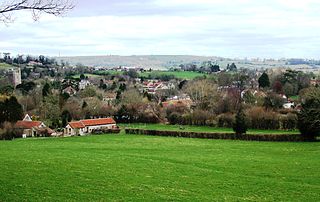
Chew Stoke is a small village and civil parish in the affluent Chew Valley, in Somerset, England, about 8 miles (13 km) south of Bristol and 10 miles north of Wells. It is at the northern edge of the Mendip Hills, a region designated by the United Kingdom as an Area of Outstanding Natural Beauty, and is within the Bristol and Bath green belt. The parish includes the hamlet of Breach Hill, which is approximately 2 miles (3.2 km) southwest of Chew Stoke itself.

Staple Fitzpaine is a village and civil parish in Somerset, England, situated 5 miles (8.0 km) south of Taunton. The village has a population of 189 and is within the Blackdown Hills Area of Outstanding Natural Beauty. The parish includes the hamlet of Badger Street.

Winscombe is a large village in the North Somerset unitary district of Somerset, South West England, close to the settlements of Axbridge and Cheddar, on the western edge of the Mendip Hills, 7 miles (11 km) southeast of Weston-super-Mare and 14 miles (23 km) southwest of Bristol. The Parish of Winscombe and Sandford, centred on the Parish Church of Church of St James the Great, includes the villages/hamlets of Barton, Hale, Oakridge, Nye, Sidcot and Woodborough.

Badgworth is a village and civil parish in Somerset, England, 2 miles (3.2 km) south west of Axbridge. According to the 2011 census it had a population of 525.
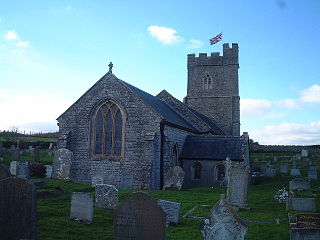
Berrow is a small residential coastal village and holiday area, a civil parish in Somerset, England, situated in between Burnham-on-Sea and Brean.

Brent Knoll, formerly known as South Brent, is a village and civil parish in Somerset, England, which lies on the southern edge of Brent Knoll – a hill with a height of 137 metres (450 ft) that dominates the low surrounding landscape of the Somerset Levels.
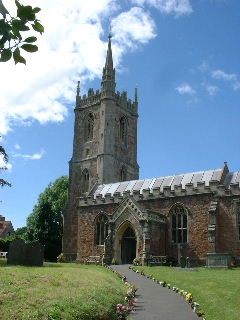
The Anglican St Andrew's Church is on the outskirts of Chew Stoke, within the English county of Somerset. The church, parts of which date from the 15th century, is a Grade II* listed building.
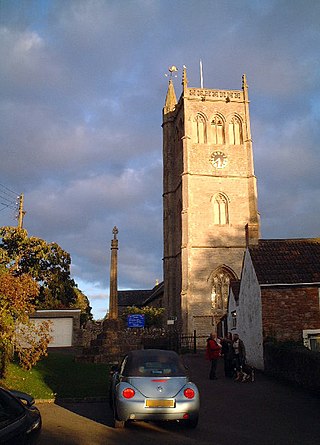
The Church of St Peter and St Paul dominates the village of Bleadon, Somerset, England.

The Church of St Peter in Huish Champflower, Somerset, England dates from the 15th century, with the north aisle being built in 1534. It has been designated by English Heritage as a Grade I listed building.

Church of St Peter, Staple Fitzpaine is Norman in origin, and has been designated as a Grade I listed building.

The Church of St John the Baptist in Axbridge, Somerset, England, was built in the 13th century and has been designated as a grade I listed building.

The Church of St Mary the Virgin in Batcombe, Somerset, England, dates from the 15th and 16th centuries and was restored in the 19th. It has been designated by English Heritage as a Grade I listed building.

The Church of St George is a Church of England parish church in Beckington, Somerset, England. It is a Norman church, dating from the 14th century. It has been designated as a Grade I listed building.
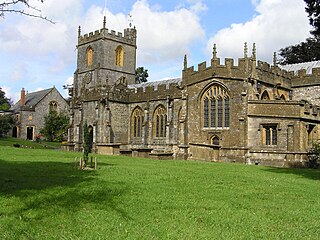
The Anglican Church of St Mary the Virgin in Chard, Somerset, England dates from the late 11th century and was rebuilt in the 15th century. It has been designated as a Grade I listed building. Due to the effects of a leak in the roof it was added to the Heritage at Risk Register in 2013.

The Church of St John the Baptist in Yeovil, Somerset, is a Church of England parish church.

The Church of St Andrew in Chew Magna, Somerset, England dates from the 12th century with a large 15th-century pinnacled sandstone tower, a Norman font and a rood screen that is the full width of the church. It is a Grade I listed building.

The Anglican Parish Church of St Nicholas and the Blessed Virgin Mary at Stowey within the English county of Somerset dates from the 13th century. It is a Grade II listed building.



















